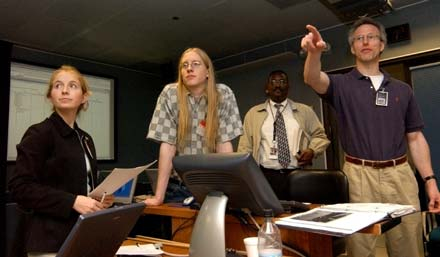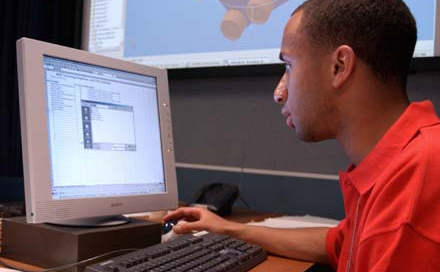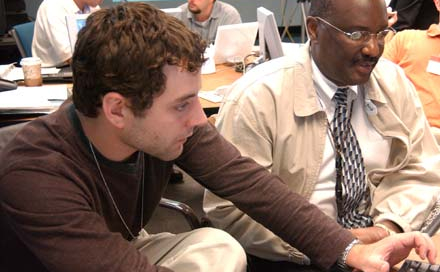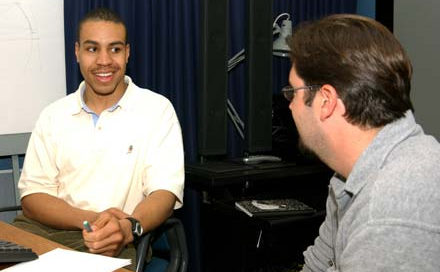NEWS | July 29, 2002
Building Blocks and Designing Students
Just as a toddler uses a set of blocks to build a structure, engineers at NASA's Jet Propulsion Laboratory, Pasadena, Calif., design conceptual space missions using a set of "blocks," each representing a different segment of requirements, to make sure that all aspects of a mission mesh with the final design.
Instead of being made of wood or cardboard, these blocks are made up of such things as power requirements, software needs, weight limits, costs, launch vehicle, science instruments - the many facets of any scientific research mission, be it a Mars orbiter or a visit to the surface.
"We're now studying advanced concepts for 2007 and beyond," said Steve Matousek, deputy manager of JPL's Solar System Advanced Studies Office. "Pre-project creation of these building blocks enables us to keep track of changing technology and requirements, and perhaps reassemble the mission, before planning goes to the implementation stage."
Center of Excellence Helps Put Blocks Together
To aid in the mission design process, JPL has established a Center of Excellence for Space Mission Architecture and Design. Tony Freeman, the center's leader, says that out of 10 such centers of excellence at JPL, this is the only one dedicated to engineering.
"The center is set up with computers and large screen wall displays so that work groups can come in and share information in real-time to see how a change in one block affects others. Teams like the Mars Smart Lander mission come in early in the program's life cycle to explore design options," Freeman said.
The center's computer network features multi-disciplinary software that connects each computer with all of the others. The software updates all stations concurrently with any design changes, so that team members "stay on the same page."
JPL and Universities Encourage Students to Have Designs on Space
As part of Matousek's efforts, he works with universities to bring engineering students to JPL to take part in advanced concepts design as part of their training and to add to project planning. "I'm really enthusiastic about this program, so I make time for it. Whenever possible, I attend college conferences and competitions in the science and engineering field," said Matousek.
Students from a senior design course at the University of Michigan visited JPL to take part in a week-long study in the design center. The 10 students were accompanied by Professor David Hyland, chair of the university's Department of Aerospace Engineering. Their design project was the Mars sample return mission, currently proposed for launch sometime in the next decade. Serving as analysts representing design teams of other classmates, the students were in regular contact with team members in Michigan as part of the exercise.
"JPL's facility is unique," said Hyland. "It uses the latest methods and acquaints students with how design will be done in their professional lives. Being here also gives them the ability to call in JPL experts when they have a design problem."
"The program gives us useful products, helps train the future workforce, and gives us a wonderful outreach opportunity to bring university students to JPL," said Matousek. "I myself was led to work at JPL by the experience of controlling a satellite as part of my undergraduate work at the University of Colorado."
JPL Staff Provides Support
Knut Oxnevad, from JPL's modeling and simulation group, led and coordinated the student visit. He said, "Many people supported this effort. In addition to 13 members of my team, 22 JPL scientists directly supported this activity. Some very senior people, with busy schedules of their own, came into the lab to support us."
In addition to teaching the students how to work concurrently, sharing all information with other team members, Oxnevad showed them the advantages of the design team environment and its quick analysis capability. They learned to use higher technology at the beginning of the design process and were able to do an analysis and come up with numbers.
"The students had a lot of energy and adapted to the technology very quickly. Most of them didn't know each other before, but they soon bonded and became a team," said Oxnevad.
Design center operations manager Paul De Florio, who builds the labs and makes them work, said, "I enjoy having students here. They constantly come up with new ways of making the room more valuable and easier for people to work in the environment."
The visit was also sponsored by the Mars Smart Lander and Mars Advanced Studies offices.
Trip to California Didn't Involve a Day at the Beach!
In addition to full days of mission design, processing and presentations, students had to keep up homework for other classes. Hyland said, "They got to walk around Old Town Pasadena some after dinner, but then they had to finish their homework and fax it back to Ann Arbor."
Student Joe Mrozinski served as project manager for the team. "That means I make sure that everyone is on task and communicating with each other. I like putting things together, so this gave me a taste of everything," he said. He plans on staying at the university to obtain a master's degree.
Rebecca Myers appreciated the all-in-one-location aspect for team members. "The facilities are so much more sophisticated. They allow the team to work together in more detail. It also gives us access to personnel who know a lot more than we do," she said.
Also planning to obtain a master's is senior Brandon Wright. He said, "It was a help to have the tremendous amount of resources in one place. Being able to see other aspects of the task projected real-time leads to a more efficient design."




